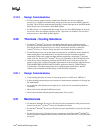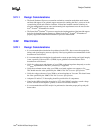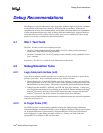
Intel
®
440GX AGPset Design Guide
4-4
Debug Recommendations
Inputs to the Slot 1 connector, from system logic (assuming a 14mA driver):
•
PWRGOOD 150 - 330 ohm
•
INIT# 150 - 330 ohm
•
LINT
[
0
]
/INTR 150 - 330 ohm
•
LINT
[
1
]
/NMI 150 - 330 ohm
•
IGNNE# 150 - 330 ohm
•
A20M# 150 - 330 ohm
Bi-directional signal to/from the Slot 1 connector:
•
PICD
[
0
]
# 150 ohm
•
PICD
[
1
]
# 150 ohm
Inputs to the Slot 1 connector, only pull-up:
•
FLUSH# 510 ohm
4.3.2 Debug Logic Recommendations
Debug Recommendations are intended to assist in the development of the Intel
®
Pentium
®
II
processor system and products utilizing it. The following are strongly recommended for early
prototype designs only.
•
Provide a push button reset circuit, do not rely on power-on reset from the power supply. A
push-button reset usually results in more repeatable results when debugging initialization
problems.
•
Include a Intel
®
Pentium
®
II processor debug port connector. Intel cannot provide debug
assistance without this connection. See the Integration tools chapter of the processor
datasheet for schematics and a signal checklist. Be sure it is the proper 0.050” x .100”
(1.27mm x 4mm) spacing connector.
•
Provide the capability to measure the processor’s case temperature (Tplate) to ensure that the
maximum temperature specification per processor Intel
®
Pentium
®
II Processor Datasheet.
•
Place an SMA style (or similar) coaxial connector on the power plane between the VRM
Header or on board voltage regulator and Slot 1 connector so that power plane noise can be
monitored on systems. Note: an SMA to BNC cable for an oscilloscope may be needed as
well. This component would only be placed during design evaluation.
•
For DP systems, an empty Slot 1 connector is not allowed because one end of the bus
termination would be missing.
•
The ITP565 requires a complete boundary scan chain. For a DP system It is recommended
that jumpers be placed on the motherboard to allow the boundary scan chain to bypass an
“empty processor slot”.
•
TRST# must be driven low during reset to all components with TRST# pins. Connecting a
pull-down resistor to TRST# will accomplish the reset of the port.


















